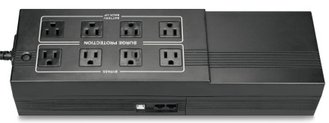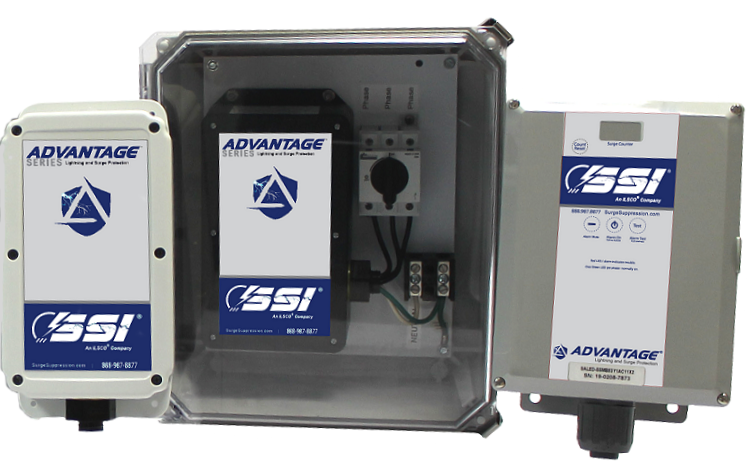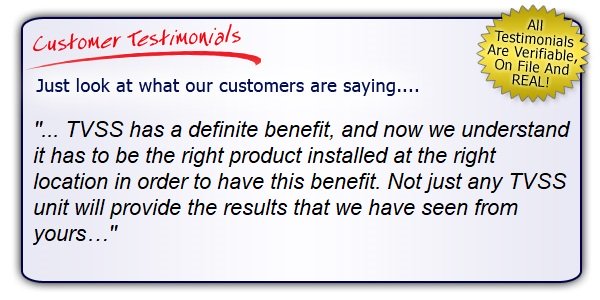High Performance UPS Surge Protectors
The importance of acquiring proper UPS surge protector devices should no longer be considered an option. In many applications, SPDs have become an NEC requirement.
Today, Uninterruptible Power Supply equipment (UPS)
have become commonplace for business, industry, military and homes.
In general, this equipment converts AC power to DC power. When power interruptions occur the UPS switches on to provide temporary "backup" power to the connected devices.
The most common UPS systems available today:
Standby: Are often found in small business's and homes and are the most affordable. Units have small battery capacity and short battery-duration.
Line-Interactive: Are a step-up from Standby Models and have an auto-transformer. These units provide an increased ability to tolerate brown outs while not tapping into the battery reserve.
Double Conversion: Are the most expensive and most advanced of the three. With these unit types, backup power is on/running continuously.
 Basic Standby UPS
Basic Standby UPSUninterruptible Power Supplies
Are Not Surge Protectors
Contrary to popular claims and apparent uses, a UPS is NOT a surge protector.
However, some, including the occasional professional, seem to think they are or at least appear to use them for that purpose. We don't recommend this.
A UPS may provide some form of partial or limited transient voltage protection through it's design. However, a properly designed surge protective device (SPD) that does not make.
ANSI/IEEE specified test results, the NEC and real world experience discourage the idea that a UPS provides quality surge protection.
UPS Units With Built-In Surge Protection
Many Uninterruptible Power Supply units are marketed as providing 'built-in' surge protection.
The questions then become:
- How good is the UPS surge protection?
- What is the UPS surge protection actually protecting?
UPS/SPD combination designs are readily available today. However, the surge protection should be carefully evaluated. Most likely, the surge protection is for down-line equipment only. Protection can also be limited to a few select receptacles leaving other equipment unprotected.
In general, these designs are limited and are not the best UPS Surge Protector option available.
- What about the UPS itself? The sensitive electronics that operate the UPS are typically not protected. If by chance some surge protection is included, it's usually very limited and typically board only.
- What's protecting the UPS power supply, other electronics and battery?
It's important to understand what the term surge protection means and how its being used for both UPS and down-line equipment.
- Are both normal and common modes protected?
- Are the protection circuits shared or are they individually dedicated?
- Exactly what type and how much protection is provided?
- How does one know if the surge protection is functioning or not?
Relying on a UPS to provide surge protection for down-line equipment is not the best option. Its not even a good option. Plus, the UPS itself is at risk from the same damaging surge activity it's marketed to protect against.
Reminder... a UPS is a UPS... Not a Surge Protector.
The Best UPS Surge Protector Options
From experience, following IEEE and FIPS recommendations provides the best UPS surge protection. SPDs in front of UPS have been very effective. This concept is now code (NEC 700.8). Additional SPDs upstream are strongly encouraged. This approach delivers UPS electronics, power supply, battery backup and down-line equipment layered protection (IEEE Std. 1100).
SPDs that provide Full Spectrum ProtectionTM are High Quality and High Performance. These SPDs are critical for advanced protection of sensitive electronics. Remember: A damaged UPS = No UPS = No Backup Power Supply.
If sensitive equipment is important enough to warrant a UPS system, the UPS warrants being protected by a properly designed High Quality, High Performance surge protective device (SPD).
Advanced Technology: Full Spectrum Surge Protectors
10-Mode, Surge BerrierTM and the Advantage® Series design, features, safety and Warranty are second to none. These unique SPDs lead the industry. Advanced Frequency Responsive CircuitryTM protects against multiple surge types found in the harshest environments.
Few SPDs protect against both Impulse and RingWave surge activity. Even fewer do it in All-Modes. Our SPDs do both.
When protecting Uninterruptible Power Supply systems from transient voltage, install Full Spectrum ProtectionTM from the leader in UPS surge protector design. Inquire about best protection methods.
Our gear is... often imitated... but rarely duplicated...
The Surge Stops HereTM
Get the Right Gear!TM
Surge BarrierTM Series Product Brochure
Return from UPS Surge Protectors to Best Surge Protector Home




